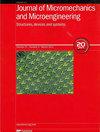动态范围可调的静电致动全金属 MEMS 皮拉尼计
IF 2.1
4区 工程技术
Q2 ENGINEERING, ELECTRICAL & ELECTRONIC
引用次数: 0
摘要
本文提出了一种动态范围可调的静电致动全金属 MEMS 皮拉尼规。与传统的固定间隙皮拉尼真空计不同,它采用静电机制来调整气体传导间隙。由于加热元件和散热器之间存在静电力,这种调整会导致过渡压力向更高压力移动。因此,皮拉尼真空计的工作范围可根据致动电压的大小进行调整。此外,还对不同气体传导间隙对应的过渡压力进行了理论估算。根据可用的间隙调整余量,在 COMSOL Multiphysics 中进行了机电和电热分析。通过对制造的器件进行实验表征,验证了分析方法。与传统设计相比,采用拟议致动机制的实验测试器件的动态范围增加了 11.2 dB。在与 CMOS 兼容的制造工艺流程中,利用静电致动,所提出的真空计可用于监测从 40 Pa 到 5×10^5 Pa 的真空度。本文章由计算机程序翻译,如有差异,请以英文原文为准。
Electrostatically actuated all metal MEMS Pirani gauge with tunable dynamic range
An electrostatically actuated all-metal MEMS Pirani gauge with a tunable dynamic range is proposed. Contrary to the conventional fixed gap Pirani gauges, an electrostatic mechanism is employed to tune the gaseous conduction gap. Due to the electrostatic force between the heating element and heat sink, this tuning results in shifting the transition pressure to a higher pressure. As a result, the operating range of the Pirani gauge can be tuned depending on the magnitude of the actuation voltage. Theoretical estimation of the transition pressure corresponding to different gaseous conduction gaps is also presented. Depending on the available margin of gap tuning, the electromechanical and electrothermal analyses are carried out in COMSOL Multiphysics. The analytical approach is validated by experimentally characterizing the fabricated device. The experimentally tested device with the proposed actuation mechanism shows an 11.2 dB increase in dynamic range in comparison to the conventional design. In a CMOS-compatible fabrication process flow, the proposed gauge can be used to monitor vacuum from 40 Pa to 5×10^5 Pa with the electrostatic actuation.
求助全文
通过发布文献求助,成功后即可免费获取论文全文。
去求助
来源期刊

Journal of Micromechanics and Microengineering
工程技术-材料科学:综合
CiteScore
4.50
自引率
4.30%
发文量
136
审稿时长
2.8 months
期刊介绍:
Journal of Micromechanics and Microengineering (JMM) primarily covers experimental work, however relevant modelling papers are considered where supported by experimental data.
The journal is focussed on all aspects of:
-nano- and micro- mechanical systems
-nano- and micro- electomechanical systems
-nano- and micro- electrical and mechatronic systems
-nano- and micro- engineering
-nano- and micro- scale science
Please note that we do not publish materials papers with no obvious application or link to nano- or micro-engineering.
Below are some examples of the topics that are included within the scope of the journal:
-MEMS and NEMS:
Including sensors, optical MEMS/NEMS, RF MEMS/NEMS, etc.
-Fabrication techniques and manufacturing:
Including micromachining, etching, lithography, deposition, patterning, self-assembly, 3d printing, inkjet printing.
-Packaging and Integration technologies.
-Materials, testing, and reliability.
-Micro- and nano-fluidics:
Including optofluidics, acoustofluidics, droplets, microreactors, organ-on-a-chip.
-Lab-on-a-chip and micro- and nano-total analysis systems.
-Biomedical systems and devices:
Including bio MEMS, biosensors, assays, organ-on-a-chip, drug delivery, cells, biointerfaces.
-Energy and power:
Including power MEMS/NEMS, energy harvesters, actuators, microbatteries.
-Electronics:
Including flexible electronics, wearable electronics, interface electronics.
-Optical systems.
-Robotics.
 求助内容:
求助内容: 应助结果提醒方式:
应助结果提醒方式:


